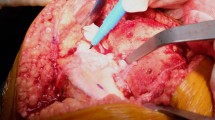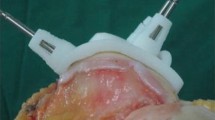Abstract
Introduction
Conventional cutting guides in total knee arthroplasty can potentially cause unintentional deviation from the planned direction and depth of bone resection resulting in malaligned components. The purpose of this study was therefore to investigate the accuracy of bone cutting jigs for both the femur and tibia using imageless navigation.
Material and methods
A total of 125 patients with a mean age of 66.7 ± 9.9 years underwent primary total knee arthroplasty with a Stryker Triathlon™ fixed bearing posterior cruciate retaining implant using imageless navigation. Coronal and sagittal position of the secured cutting jig was recorded and bone resection was checked with a rectangular probe attached to a navigation tracker.
Results
There were significant within group differences for the femoral sagittal cut (mean δ = 0.9° [31 %]; p = 0.00001), femoral depth medial compartment (mean δ = 0.5 mm [5 %]; p = 0.001), femoral depth lateral compartment (mean δ = 0.7 mm [7 %]; p = 0.00001), proximal tibial cut (mean δ = 0.3 mm [25 %]; p = 0.001), tibial depth medial compartment (mean δ = 0.6 mm [10 %]; p = 0.0001) and tibia depth lateral cut (mean δ = 0.4 mm [5 %]; p = 0.002). Deviation of more than 2° was observed for the distal cut in the sagittal plane in 17 % and in 9.6 % for the proximal tibial cut in the sagittal plane of all patients.
Conclusion
The results of this study demonstrated significant differences between the dialed in cut and “actual” bone resection achieved for all planes for both the femur and tibia. The femur sagittal cut demonstrated a tendency for an extended cut and the tibia showed a tendency for varus.





Similar content being viewed by others
References
Dunbar MJ, Gross M (1995) Critical steps in total knee arthroplasty. A method of analyzing operative procedures. Int Orthop 19(5):265–268
Gromov K, Korchi M, Thomsen MG, Husted H, Troelsen A (2014) What is the optimal alignment of the tibial and femoral components in knee arthroplasty? An overview of the literature. Acta Orthop 85(5):480–487
Teter KE, Bergman D, Colwell CW (1995) Accuracy of intramedullary versus extramedullary tibial alignment cutting systems in total knee arthroplasty. Clin Orthop 321:106–110
Mullaji AB, Shetty GM, Lingaraju AP, Bhayde S (2013) Which factors increase risk of malaligment of the hip-knee-ankle axis in TKA? Clin Orthop Relat Res 471:134–141
Chin PL, Yang KY, Yeo SJ, Lo NN (2005) Randomized control trial comparing radiographic total knee arthroplasty implant placement using computer navigation versus conventional technique. J Arthroplasty 20(5):618–626
Haaker RG, Stockheim M, Kamp M, Proff G, Breitenfelder J, Ottersbach A (2005) Computer-assisted navigation increases precision of component placement in total knee arthroplasty. Clin Orthop Relat Res 433:152–159
Sparmann M, Wolke B, Czupulla H, Banzer D, Zink A (2003) Positioning of total knee arthroplasty with and without navigation support. J Bone Joint Surg (Br) 85:830–835
Ritter MA, Davis KE, Meding JB, Pierson JL, Berennd MR, Malinzak RA (2011) The effect of alignment and BMI on failure of total knee replacement. J Bone Joint Surg Am 93(17):1588–1596
Minns RJ (1992) Surgical implant design for the accurate cutting of bone for implant fixation. Clin Mater 10:207–212
Iorio R, Bolle G, Conteduca F, Valeo L, Conteduca J, Mazza D, Ferretti A (2013) Accuracy of manual instrumentation of tibial cutting guide in total knee arthroplasty. Knee Surg Sports Traumatol Arthrosc 21:2296–2300
Ng FY, Jiang XF, Zhou WZ, Chiu KY, Yan CH, Fok MWM (2013) The accuracy of sizing the femoral component in total knee replacement. Knee Surg Sports Traumatol Arthrosc 21:2309–2313
Nakahara H, Matsuda S, Moro-oka T, Okazaki K, Tashiro Y, Iwamoto Y (2012) Cutting error of the distal femur in total knee arthroplasty by use of a navigation system. J Arthroplasty 27(6):1119–1122
Kim TK, Chang CB, Kang YG, Chung BJ, Cho HJ, Seong SC (2010) Execution of bone resection and implant fixation in computer-assisted minimally invasive total knee arthoplasty. Knee 17:23–28
James TP, McGonigle OP, Hasan IS, Smith EL (2013) Adjustable slot cutting guide for improved accuracy during bone resection in total knee arthroplasty. J Med Devices 7(4):044502,1–6
Bathis H, Perlick L, Tigart M, Perlick C, Luring C, Griffka (2005) Intraoperative cutting errors in total knee arthroplasty. Arch Orthop Trauma Surg 125(1):16–20
Yau WP, Chiu KY (2008) Cutting errors in total knee replacement: assessment by computer assisted surgery. Knee Surg Sports Traumatol Arthrosc 16:670–673
Hasegawa M, Yoshida K, Wakabayashi H, Sudo A (2013) Cutting and implanting errors in minimally invasive total knee arthroplasty using a navigation system. Int Orthop 37:27–30
Otani T, Whiteside LA, White SE (1993) Cutting errors in preparation of femoral components in total knee arthroplasty. J Arthroplasty 8(5):503–510
Roche M (2014) Robotic-assisted unicompartmental knee arthroplasty: the mako experience. Clin Sports Med 33:123–132
Vanlommel L, Vanlommel J, Claes S, Bellemans J (2013) Slight undercorrection following total knee arthroplasty results in superior clinical outcomes in varus knees. Knee Sports Traumatol Arthrosc 21:2325–2330
Magnussen RA, Weppe F, Demey G, Servien E, Lustig S (2011) Residual varus alignment does not compromise results of TKAs in patients with preoperative varus. Clin Orthop Relat Res 469:3443–3450
Biant LC, Yeoh K, Walker PM, Bruce WJM, Walsh WR (2008) The accuracy of bone resections made during computer navigated total knee replacement. Do we resect what the computer plans to resect. Knee 15:238–241
Catani F, Biasca N, Ensini A, Leardini A, Bianchi L, Digennari V, Giannini S (2008) Alignment deviation between bone resection and final implant positioning in computer-navigated total knee arthroplasty. J Bone Joint Surg Am 90:765–771
Author information
Authors and Affiliations
Corresponding author
Rights and permissions
About this article
Cite this article
Hohmann, E., Tetsworth, K. Do manual cutting guides for total knee arthroplasty introduce systematic error?. International Orthopaedics (SICOT) 40, 277–284 (2016). https://doi.org/10.1007/s00264-015-2963-8
Received:
Accepted:
Published:
Issue Date:
DOI: https://doi.org/10.1007/s00264-015-2963-8




